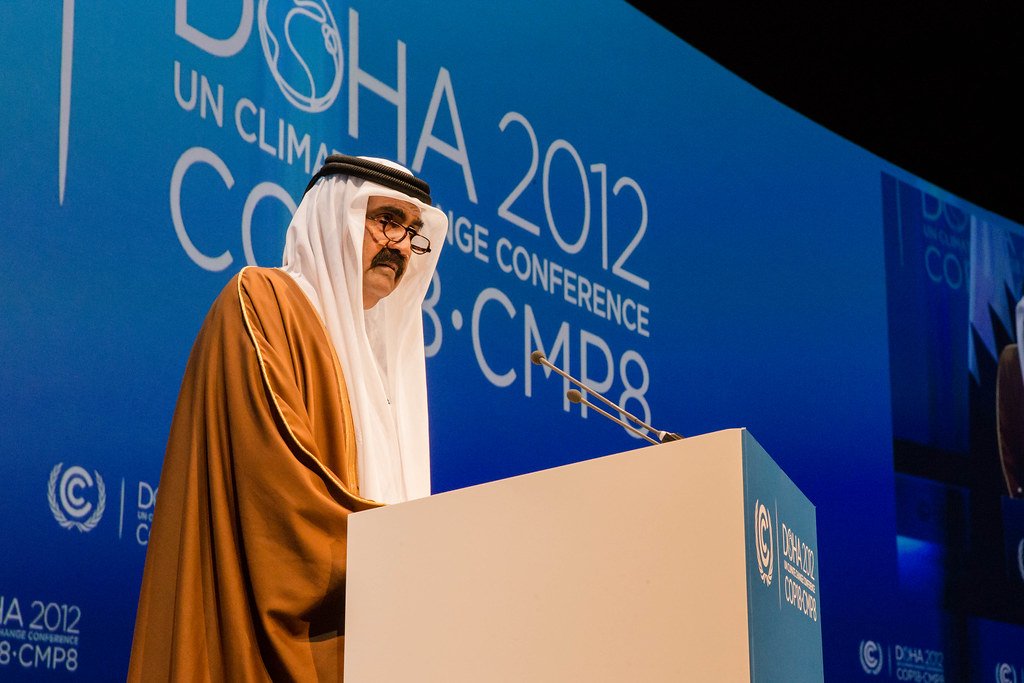

The world’s climate negotiators are currently convened in Doha, Qatar, for the annual United Nations climate change conference, or “,” where they’re attempting to finally work out a treaty to reduce global carbon emissions and prevent catastrophic warming. I’m observing COP18 on behalf of the , and after three days of sitting in on plenaries and gleaning scuttlebutt in corridors, I can confidently say that the negotiations aren’t going well. As serious climate change grows unavoidable, the conference has taken on an added focus: rather than just fighting climate change, COP18’s attendees are talking about adapting to it.
For years, touting adaptation at COP meetings was considered tantamount to surrender. Once we diverted our attention to adapting, the thinking went, we’d lose our will to reduce carbon emissions, or fool ourselves into believing that we could survive catastrophic warming. (The fact that people like Exxon CEO took up the adaptation cause certainly didn’t help its image.) But nations have consistently failed to negotiate a treaty to reduce CO2 — and even if we miraculously ended all emissions tomorrow, there’s already so much carbon in the atmosphere that substantial warming is all but assured. As a result, adaptation has been gaining prominence at UN conferences for several years now, and it has never been more central to the agenda than in 2012.
In a way, Doha is the perfect place to discuss climate adaptation. The Qatari capital, with its parched desert air, elegant minarets, and stunted palm trees, does not resemble New York City in many particulars. But Doha does share at least one trait with New York: both cities are in danger of drowning.
Doha’s surreal, eclectic skyline leans out over the Persian Gulf, a body of water whose annual rate of rise is and growing. While this low-lying metropolis is in perhaps the gravest peril of any Middle Eastern city, the Gulf’s rise threatens much of the region —even a meter of sea level rise would swamp over 25,000 square miles and displace 37 million people, according to Dr. Najib Saab, Secretary General of the Arab Forum for Environment and Development. Throw in dwindling freshwater, crop failure, and brutal heat, and you have a recipe for further chaos in a region not exactly known for its stability. Of course, the Middle East is hardly alone in its vulnerability: as a terrifying World Bank revealed last month, unless you’re a farmer in Siberia, climate change will probably make you very poor and very unhappy.
Among climate change’s impacts is likely to be an increase in the frequency and intensity of , and as Superstorm Sandy demonstrated all too vividly, not even wealthy societies are equipped to deal with the damages. Forty-one deaths and in requested aid later, New York appears to be realizing that, while constructing tide gates, restoring wetlands, and installing absorptive streets might be expensive, these proactive measures are a heck of a lot cheaper than repeatedly rebuilding a ruined city.
Although Doha hasn’t yet experienced a revelation of its own, adaptation to climate change has definitely broken down the door at COP18. Groups like the UN’s Food and Agriculture Organization distribute literature on the benefits of ; insurance companies lobby all who will listen about smarter coastal development; and the Red Cross to suggest how climate change will help spread mosquito-borne diseases. At the booth of the , Thomas Nocke showed me maps suggesting that many of Germany’s wine growers will have to switch from white grapes to red by 2100. For every foreseeable impact, it seems, there is a strategy, even if some of these strategies remain theoretical.
This newfound emphasis isn’t limited to side sessions, as adaptation has infiltrated even the negotiations themselves. During a recent meeting of the Ad Hoc Working Group on Longterm Cooperative Action —a committee whose deliberations are usually as snore-inducing as its name would suggest —Filipino delegate Bernaditas Muller shook things up by raging that fully-developed countries weren’t adequately supporting the , a pot of money partly dedicated to helping less fortunate countries adapt. “Even as I speak,” Muller cried, her voice shaking, “a Category Four typhoon is heading toward my country... and what we have now is an empty shell of a fund!”
Muller’s words reveal that, for all the rhetoric, adaptation will remain a pipe dream for many developing countries until the richer ones pony up. Although wealthy countries claimed that they would fill the fund with $100 billion annually by 2020, the GCF currently contains only a small portion of the promised money, leaving many observers that the promised money will ever materialize.
How would poor countries use the funding if they got it? One of the ways might be to help their citizens undertake the most radical form of adaptation: large-scale migration. Climate disturbances displaced 20 million people in 2008 alone, according to Renate Christ, Secretary of the Intergovernmental Panel on Climate Change. As such disturbances grow more frequent, migration might become preemptive rather than reactive. “Our goal is that migration should be a choice for poor communities,” says Kevin Henry of CARE International. Better that people move in anticipation of floods and droughts, in other words, than be forced to flee after calamity has struck.
